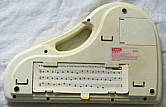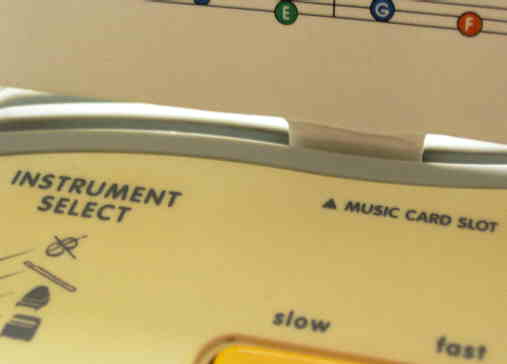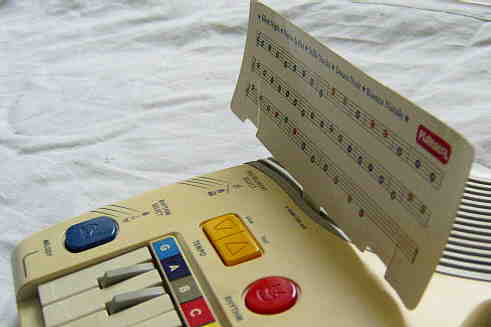Playskool
- Kid Keys PS-635 (squarewave keyboard with POKEY
percussion)
This monophonic toy keyboard from 1993 has nice POKEY rhythm and many
sound similarities with the great Hing
Hon EK-001. Unfortunately only 3 rhythms can be selected by hand,
despite its demo tunes contain many additional rhythms.
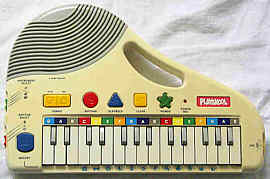
main features:
-
29 mini keys
-
monophonic main voice
-
4 OBS preset sounds {violin, flute, piano, organ} (selected by a slide
switch)
-
3 OBS preset rhythms with unique percussion
-
volume knob
-
tempo +/- buttons (16 steps)
-
sound generation is based on multipulse squarewave and resembles much the
Hing
Hon EK-001. Exceptional is the "organ" sound, which is an incredible
sinister and massive sounding, powerful church organ variant with much
reverberation. The piano sound ignores key press duration.
-
percussion sounds {base, snare, hihat, cowbell} sound very electronic and
extremely impulsive and are best comparable with Atari POKEY chip
sounds. They all use digital envelopes and either squarewave or shift register
noise. The cowbell (squarewave with digital envelope and zipper noise)
sounds like a bottle hit. The snare uses a very rough and impulsive hissing
shift- register noise (like a historical videogame's MG shot), the hihat
uses a quieter hiss. The base is just a quick fading squarewave. These
percussion in spite of their basslessness sound incredible vigorous and
are an as outstanding sound discovery as the nowadays so well known and
everywhere imitated TR-909 base drum.
-
primitive sequencer (record/ playback, no edit, stores 62 notes)
-
12 demo melodies (monophonic monotos with each a different rhythm)
-
headphone jack
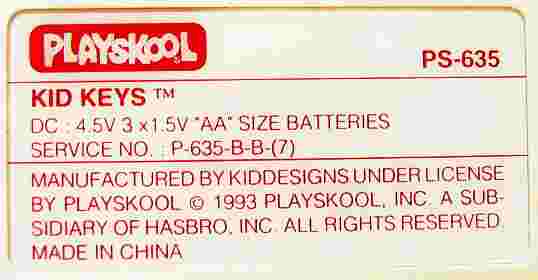 On
the type label stands: "Manufactured by Kiddesigns under license
by Playskool © 1993 Playskool. Inc. a subsidiary of
Hasbro.
Inc. all rights reserved. Made in China." On
the type label stands: "Manufactured by Kiddesigns under license
by Playskool © 1993 Playskool. Inc. a subsidiary of
Hasbro.
Inc. all rights reserved. Made in China." |
eastereggs:
-
When the sound select switch is set into intermediate positions, the CPU
switches quickly between the selected sounds, resulting in a rough and
buzzy kind of fast arpeggiator effect (like known from C64 SID musics).
notes:
The key colours of this instrument look like imitated from the Casio
EP-20. The PS-635 has basically the same exceptional POKEY
sounds like the great Hing Hon EK-001 (see there),
and by its behaviour the CPU seems to be indeed a variant of it; e.g. selecting
multiple preset sound lines simultaneously results in the same buzzy arpeggiator
timbres. Unfortunately in opposite to the EK-001 only 3 preset rhythms
and 4 preset sounds can be selected, which limits its use a lot.
The 12 demo tunes use many additions rhythms, thus it may be possible
to enable these also for manual play as keyboard matrix eastereggs. Likely
it
is at least easily possible to add a switch or potentiometer to disable
the main voice during the demos to use their rhythm track as a drum machine.
(I haven't analyzed the hardware closer yet.)
The 12 demo melodies are simple monophonic monotos (sound loops) those
employ the currently selected main voice sound but each of them has its
own rhythm. The demos are:
-
Happy Birthday
-
London Bridge is Falling Down
-
Oh Susanna
-
Mary Had a Little Lamb
-
Silent Night
-
Jingle Bells
-
Twinkle Twinkle Little Star
-
For Elise
-
In a Persian Market
-
Home Sweet Home
-
La Cucaracha
-
Santa Lucia
Don't be confused if anybody tells you that this instrument would have
somewhere a "music card slot"...
On the case top there is indeed a small rectangular hole labelled this
way and in the case bottom is a compartment for musical score cards of
cardboard. My used specimen came with these five cards:
-
Happy Birthday
-
Oh Susanna
-
Silent Night
-
Jingle Bells
-
In a Persian Market
These score cards can be inserted with their protruding end into this slot
(which holds them in a very wacky and fragile way), but this will not affect
in any way the electronic operation of this instrument. They are in no
way anything sophisticated like ROM cartridges but only note sheets and
these wacky cards are even almost impossible to remove from their compartment
without folding them badly or even accidentally tearing them. (One of mine
came already torn.)
The sequencer is a similarly banal thing like with My
Music Center, but in opposite to the latter this one is always
recording the notes you play (until the memory is full, but no pauses),
and it does not loose its contents unless "clear" is pressed. Even powering
off into standby mode (it has a button instead of a power switch) does
not clear the memory contents. The playback speed can not be changed with
the tempo controls.
circuit bending details
Nick Santos sent me an e-mail
with the following hardware tips about the
Playskool PS-635:
"Although I am still in the experimentation and documentation
stage of this bend I have found some promising bends. As you may
have noticed, pins 10-26 seem to deal with they keys and buttons of this
device. I saw that pins 10 and 12 were being used but pin 11 was
conspicuously unused, I used some wire and probes and proceeded to connect
pin 11 to the other key control pins with pleasing results pin 11 connected
to pin 15, 16 17 or 18 will produce the kick, cowbell, loud snare and soft
snare respectively. When pin 11 is connected to pins 21-26 it will
produce lower pitch notes that were not included in the design. You
mentioned that you would like to use the pre programmed rhythms and cancel
out the main instrument voice, I have discovered how to do this as well.
Connect the pin nearest the headphone jack of the capacitor nearest the
headphone jack, to pin 1 of the instruments main chip, this will completely
cut out the main voice and leave the rhythm (if you attach to the wrong
pole of the capacitor a very faint main voice will remain) to do the opposite
and strip away the rhythm from the songs connect the same pin of the capacitor
to pins 5 or 6 of the main chip (it will also boost the volume).
...
I hope this helps you and helps other people who wish to bend this
instrument as well."
Attention: I haven't verified this
info yet. |
A much better instrument with the same sound style is the Hing
Hon EK-001. Another monophonic instrument with multiple demos and
this sound hardware is the Yongmei MS-210B.
(Sorry, I initially confused its name with a wrong keyboard.) Someone e-mailed
me that another close variant was the Kiddesign - Barbie Music Center
BE-630.
| removal
of these screws voids warranty... |
|
|
 |

|
|
| |
back
|
|
 On
the type label stands: "Manufactured by Kiddesigns under license
by Playskool © 1993 Playskool. Inc. a subsidiary of
Hasbro.
Inc. all rights reserved. Made in China."
On
the type label stands: "Manufactured by Kiddesigns under license
by Playskool © 1993 Playskool. Inc. a subsidiary of
Hasbro.
Inc. all rights reserved. Made in China."